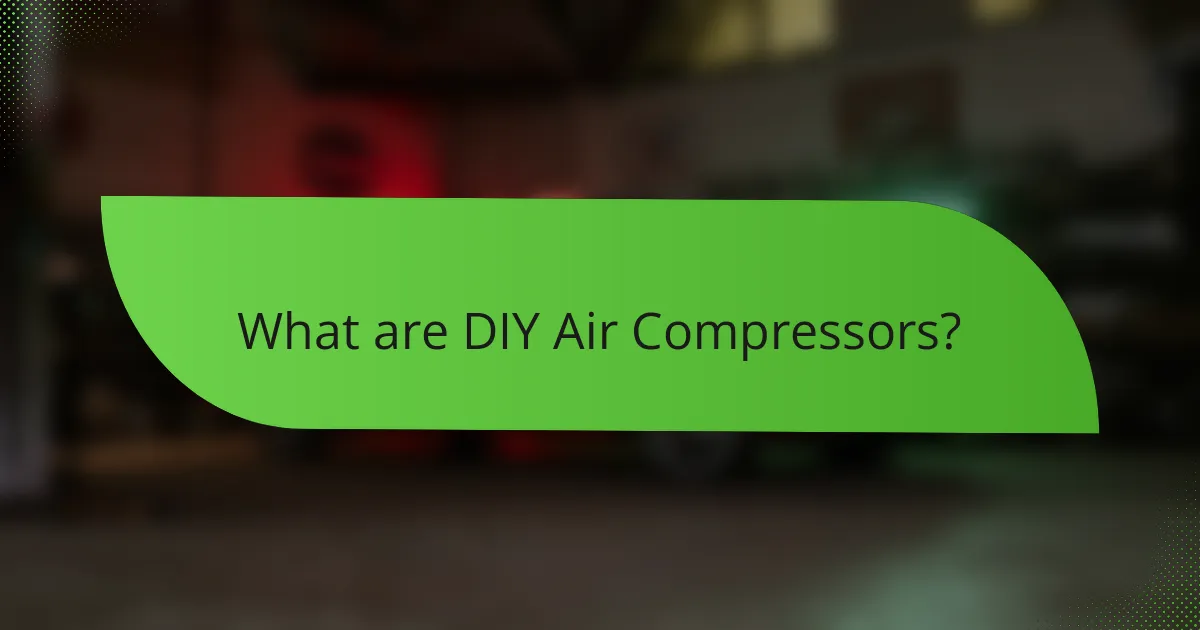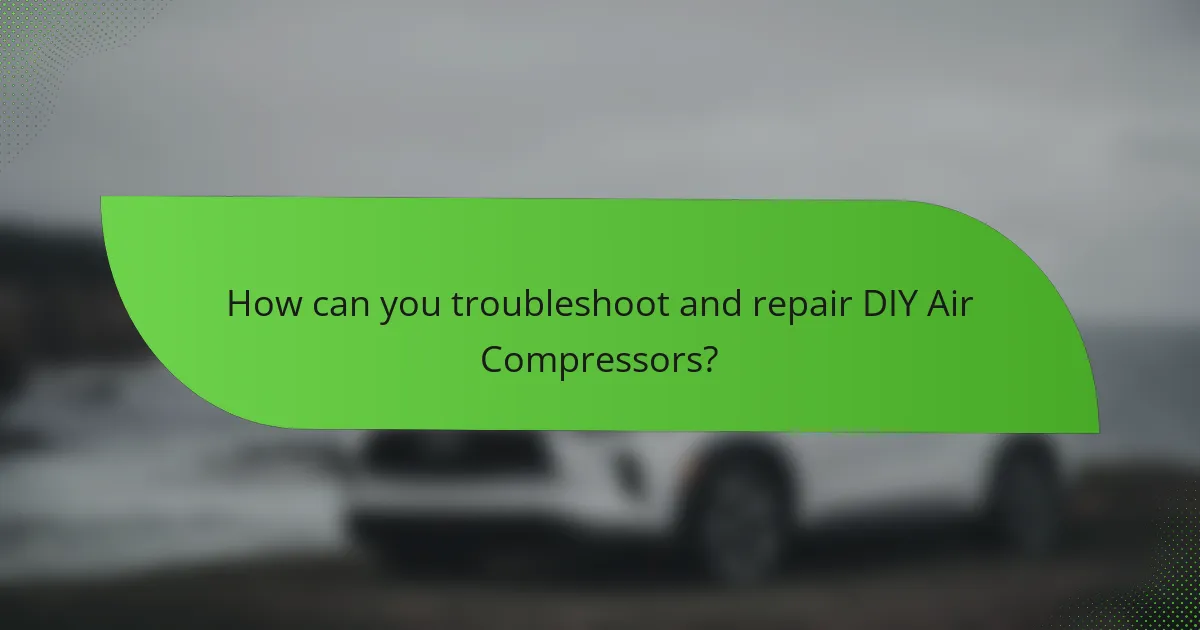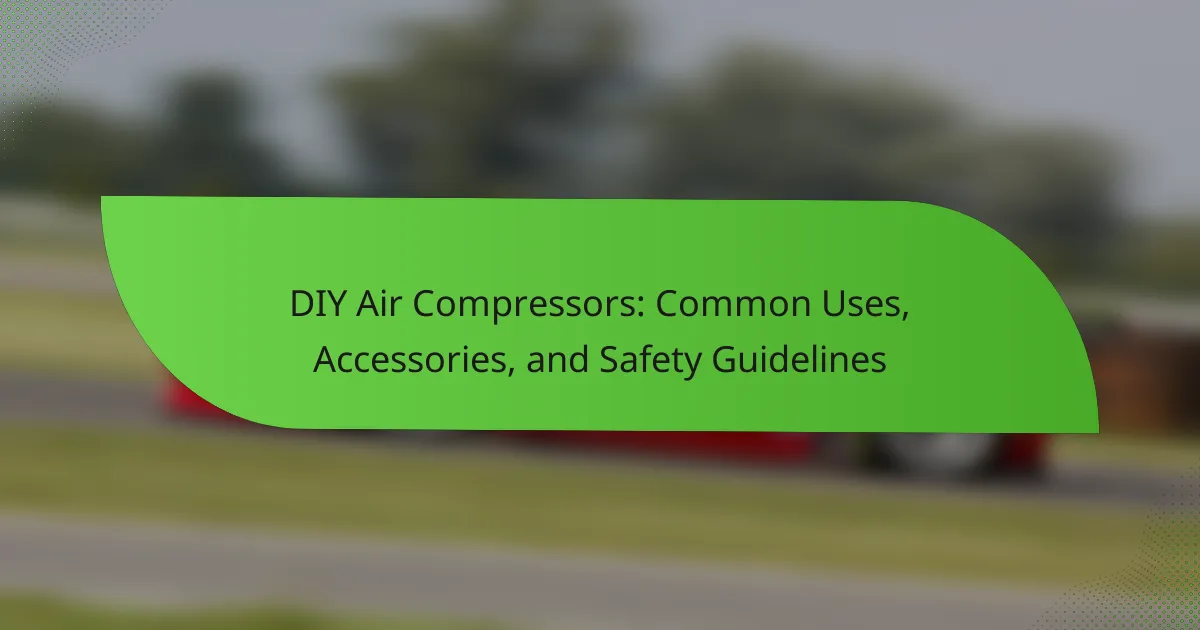DIY air compressors are homemade devices that compress air for various applications, including inflating tires, powering pneumatic tools, and spray painting. Constructed from accessible materials, these compressors consist of a motor, a pump, and a storage tank, with the motor driving the pump to compress air. Common issues include air leaks, insufficient pressure, overheating, and moisture buildup, which can hinder performance. Troubleshooting involves identifying specific problems, inspecting components like the power source and air filter, and performing regular maintenance to ensure efficient operation. This article provides guidance on addressing these common issues and maintaining DIY air compressors effectively.

What are DIY Air Compressors?
DIY air compressors are homemade devices designed to compress air for various applications. They can be constructed from readily available materials and components. Common uses include inflating tires, powering pneumatic tools, and spray painting. DIY air compressors typically utilize a motor, a pump, and a storage tank. The motor drives the pump to compress air into the tank. This compressed air can then be released for use as needed. Many DIY enthusiasts build these compressors for cost savings or customization. Building a DIY air compressor requires knowledge of basic mechanics and safety precautions.
How do DIY Air Compressors function?
DIY air compressors function by converting power into potential energy stored in pressurized air. They typically use an electric motor or gasoline engine to drive a piston or diaphragm. This action compresses air and forces it into a storage tank. The compressed air is then released through a valve for use in various applications. Common uses include inflating tires and powering pneumatic tools. The efficiency of a DIY air compressor depends on its design and components. Proper maintenance ensures optimal performance and longevity.
What are the essential components of a DIY Air Compressor?
The essential components of a DIY air compressor include a motor, a compression chamber, a storage tank, and a pressure regulator. The motor powers the compressor, driving the piston or rotary mechanism. The compression chamber is where air is compressed to increase pressure. The storage tank holds the compressed air for later use. The pressure regulator controls the output pressure, ensuring it meets the requirements of the tools being used. Additionally, an air filter and safety valve are important for maintaining air quality and preventing overpressure. These components work together to create a functional air compressor system.
How do these components work together in a DIY Air Compressor?
A DIY air compressor consists of several key components that work together to compress air. The motor powers the compressor pump, which draws in air. The pump then compresses this air into a smaller volume. The compressed air is stored in a tank for later use. A pressure switch regulates the air pressure in the tank. When the tank reaches a set pressure, the switch turns off the motor. An outlet valve releases the compressed air for tools or other applications. Each component must function correctly for the compressor to operate efficiently. Proper assembly and maintenance ensure optimal performance and longevity.
What are the common applications of DIY Air Compressors?
DIY air compressors have various common applications. They are frequently used for inflating tires, which is essential for vehicle maintenance. Additionally, they are utilized for powering pneumatic tools like nail guns and spray guns. DIY air compressors also serve in cleaning tasks, such as blowing dust from equipment. They can be employed for painting projects, providing a smooth finish with spray paint. Moreover, they assist in airbrushing, allowing for detailed artwork. Finally, they are useful for operating air-powered devices in woodworking or metalworking. These applications demonstrate the versatility and practicality of DIY air compressors in everyday tasks.
How can DIY Air Compressors be used in home projects?
DIY air compressors can be used in home projects for various applications. They are essential for powering tools like nail guns, spray guns, and air wrenches. These compressors provide a reliable source of compressed air for inflating tires and sports equipment. Additionally, they can be used for cleaning hard-to-reach areas with air blasts. DIY air compressors also assist in painting projects by providing an even spray application. Their versatility makes them valuable for tasks like sanding and grinding. According to a study from the Home Improvement Research Institute, air compressors significantly enhance efficiency in home improvement tasks.
What industries benefit from DIY Air Compressors?
Several industries benefit from DIY air compressors. The automotive industry uses them for tire inflation and powering pneumatic tools. Construction relies on air compressors for nail guns and heavy equipment. Manufacturing industries utilize them for assembly line operations and powering machinery. The woodworking sector employs air compressors for finishing tools and spray painting. Agriculture also benefits by using them for crop spraying and equipment maintenance. Lastly, the home improvement sector leverages DIY air compressors for various projects and repairs. These applications demonstrate the versatility and utility of DIY air compressors across multiple sectors.

What are the most common issues with DIY Air Compressors?
The most common issues with DIY air compressors include air leaks, insufficient pressure, and overheating. Air leaks often occur at fittings, hoses, or the tank. Insufficient pressure can result from a faulty regulator or inadequate power supply. Overheating may be caused by prolonged use or lack of proper ventilation. Additionally, moisture buildup in the tank can lead to rust and corrosion. These issues can affect performance and efficiency. Regular maintenance can help prevent these problems.
What symptoms indicate a problem with a DIY Air Compressor?
Common symptoms indicating a problem with a DIY air compressor include unusual noises, loss of pressure, and excessive vibration. Unusual noises may suggest mechanical issues or worn components. Loss of pressure can indicate leaks in hoses or fittings. Excessive vibration may result from an unbalanced motor or loose parts. Additionally, overheating may occur due to inadequate lubrication or airflow obstruction. Inspecting these symptoms can help identify underlying issues in the compressor’s operation.
How can you identify a loss of pressure in your DIY Air Compressor?
To identify a loss of pressure in your DIY air compressor, check the pressure gauge. A reading below the normal operating range indicates a loss. Inspect the air hoses for visible leaks or damage. Bubbles forming around connections suggest air escaping. Examine the fittings and seals for wear. Worn components often lead to pressure loss. Listen for hissing sounds during operation. This noise typically indicates escaping air. Lastly, monitor the compressor’s performance. A decrease in airflow or longer recovery times can signal pressure issues. Regular maintenance helps prevent these problems.
What does unusual noise from a DIY Air Compressor signify?
Unusual noise from a DIY air compressor signifies potential mechanical issues. These noises can indicate problems such as loose components, worn-out parts, or insufficient lubrication. For instance, rattling sounds may suggest loose screws or brackets. A hissing noise could point to an air leak in the system. Additionally, grinding noises often indicate worn bearings or a failing motor. It’s essential to address these sounds promptly to prevent further damage. Regular maintenance and inspection can help identify and resolve these issues early.
What are the typical causes of these issues?
Typical causes of issues with DIY air compressors include mechanical failures, insufficient maintenance, and improper usage. Mechanical failures can arise from worn-out parts like pistons or valves. Insufficient maintenance often leads to oil leaks or clogged filters. Improper usage may involve overloading the compressor beyond its capacity. Environmental factors like extreme temperatures can also contribute to these issues. Regular inspections and maintenance can help prevent many of these problems.
How does a clogged air filter affect a DIY Air Compressor?
A clogged air filter negatively impacts a DIY air compressor’s performance. It restricts airflow, reducing the compressor’s ability to intake air efficiently. This leads to decreased pressure output and longer cycle times. In severe cases, it can cause overheating due to increased strain on the motor. A study by the U.S. Department of Energy indicates that restricted airflow can reduce efficiency by up to 20%. Regular maintenance of the air filter is crucial for optimal operation.
What role does oil play in the performance of a DIY Air Compressor?
Oil lubricates the moving parts of a DIY air compressor, reducing friction and wear. This lubrication enhances the compressor’s efficiency and lifespan. Additionally, oil helps in cooling the compressor during operation. Proper oil levels can prevent overheating and potential damage. Oil also aids in sealing, which improves air pressure retention. A well-lubricated compressor operates more quietly and smoothly. Regular oil maintenance is crucial for optimal performance. Without adequate oil, the compressor may experience increased wear and reduced functionality.

How can you troubleshoot and repair DIY Air Compressors?
To troubleshoot and repair DIY air compressors, first identify the issue. Common problems include lack of pressure, unusual noises, and overheating. Check the power source and ensure it is functioning. Inspect the air filter for clogs and clean or replace it if necessary. Examine the hoses for leaks or damage, as these can affect performance. Verify that the pressure switch is operational and adjust it if needed. If the compressor is overheating, check for proper ventilation and oil levels. Replace worn or damaged parts as required. Regular maintenance can prevent many issues, ensuring efficient operation.
What steps should you follow to troubleshoot a DIY Air Compressor?
To troubleshoot a DIY air compressor, start by checking the power supply. Ensure the compressor is plugged in and the circuit breaker is not tripped. Next, inspect the air filter for clogs and clean or replace it if necessary. Examine the pressure switch for proper operation; it should activate when the tank pressure drops. Look for any leaks in the hoses or connections; use soapy water to identify bubbles indicating leaks. Verify that the oil level is adequate if the compressor is oil-lubricated. Check the compressor’s motor for overheating; allow it to cool down if it is too hot. Lastly, consult the user manual for specific troubleshooting guidelines related to your model. These steps address common issues effectively and can help restore functionality.
How do you check for leaks in your DIY Air Compressor?
To check for leaks in your DIY air compressor, visually inspect all connections and fittings. Look for any signs of air escaping, such as hissing sounds. Apply soapy water to joints and connections; bubbles will form if there is a leak. Tighten any loose fittings to see if the issue resolves. Use a pressure gauge to monitor pressure drops over time. A significant drop indicates a leak. Regular maintenance can prevent leaks from developing. Keeping your compressor in good condition is essential for optimal performance.
What maintenance tips can help prevent common issues?
Regular maintenance can significantly prevent common issues with air compressors. Check and change the oil as recommended by the manufacturer. Clean or replace air filters to ensure proper airflow. Inspect and tighten all connections and fittings to prevent leaks. Drain the moisture from the tank regularly to avoid rust and corrosion. Test the pressure relief valve to ensure it operates correctly. Keep the compressor clean and free from dust and debris. Schedule annual professional inspections for comprehensive maintenance. Following these tips can extend the lifespan of the compressor and enhance its performance.
What are some effective repair techniques for DIY Air Compressors?
Effective repair techniques for DIY air compressors include checking for leaks, replacing worn seals, and cleaning the air filter. First, inspect all connections and hoses for air leaks. Use soapy water to identify leaks by observing bubbles forming. Next, worn seals can be replaced to ensure proper pressure retention. Additionally, a clean air filter improves airflow and efficiency. Regular maintenance, such as oil changes for oil-lubricated compressors, is also essential. Monitoring pressure levels can help identify issues early. These techniques enhance performance and extend the lifespan of the compressor.
How can you replace a faulty compressor component?
To replace a faulty compressor component, first, disconnect the power supply to ensure safety. Next, remove any necessary covers or panels to access the compressor. Detach the faulty component by unscrewing or unclipping it from the assembly. Install the new component by reversing the removal process, ensuring secure connections. Finally, reassemble the compressor and restore power to test functionality. Following these steps is crucial for effective repair and safety.
What tools are necessary for DIY Air Compressor repairs?
Necessary tools for DIY air compressor repairs include wrenches, screwdrivers, and pliers. Wrenches are essential for loosening and tightening bolts. Screwdrivers help in removing and securing screws. Pliers assist in gripping and manipulating small components. A multimeter is useful for checking electrical connections. An air pressure gauge is important for monitoring pressure levels. A replacement part kit may also be necessary for specific repairs. These tools enable effective troubleshooting and repair of common air compressor issues.
What are the best practices for maintaining DIY Air Compressors?
Regularly check the oil levels in DIY air compressors. Maintaining proper oil levels ensures smooth operation and prevents engine damage. Change the oil according to the manufacturer’s recommendations, typically every 100 hours of use. Inspect air filters frequently and replace them when dirty. Clean filters enhance airflow and efficiency. Drain the moisture from the tank after each use. Moisture accumulation can cause rust and damage. Inspect hoses and connections for leaks regularly. Leaks reduce efficiency and can lead to pressure loss. Store the compressor in a dry, cool place to avoid environmental damage. Following these practices prolongs the lifespan of DIY air compressors.
How often should you perform routine maintenance on a DIY Air Compressor?
Routine maintenance on a DIY air compressor should be performed every three to six months. This frequency helps ensure optimal performance and longevity of the unit. Regular checks can prevent common issues such as air leaks and pressure loss. Additionally, cleaning or replacing the air filter should be done every month if the compressor is used frequently. Following these guidelines can keep the compressor functioning efficiently. Neglecting maintenance can lead to costly repairs and reduced efficiency over time.
What tips can help extend the lifespan of your DIY Air Compressor?
Regular maintenance is essential to extend the lifespan of your DIY air compressor. Check and change the oil as recommended by the manufacturer. Clean or replace the air filter frequently to ensure optimal airflow. Inspect the hoses for leaks and cracks to prevent pressure loss. Keep the compressor in a dry, well-ventilated area to avoid rust and overheating. Drain the moisture from the tank regularly to prevent corrosion. Ensure all connections are tight to avoid air loss. Lastly, avoid overloading the compressor beyond its capacity to maintain efficiency. Following these tips can significantly enhance the durability and performance of your air compressor.
DIY air compressors are homemade devices used to compress air for various applications such as inflating tires, powering pneumatic tools, and spray painting. This article provides an in-depth overview of the essential components, functionality, and common applications of DIY air compressors, along with troubleshooting methods for typical issues like air leaks and overheating. It also outlines effective repair techniques, maintenance tips, and best practices to extend the lifespan of these compressors, ensuring optimal performance and efficiency. Readers will gain valuable insights into identifying problems, performing repairs, and maintaining their DIY air compressors for various home and industrial projects.



